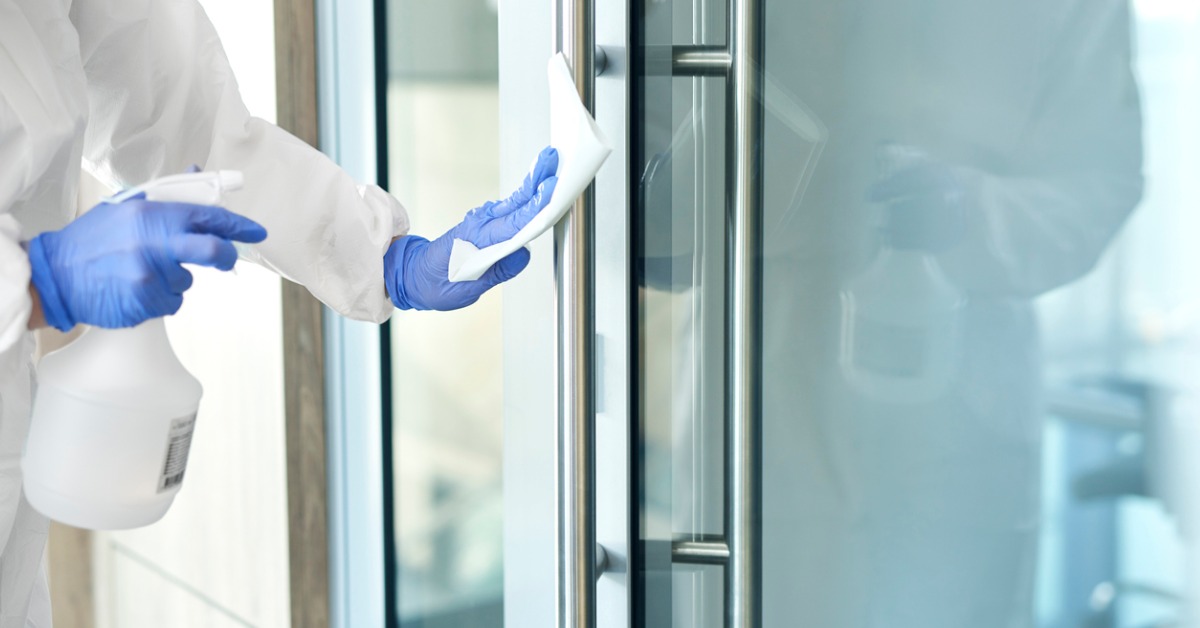
It took a pandemic for the general public to take an interest in how clean and safe their surroundings are. Before COVID-19 few people gave a second thought to the difference between cleaning and disinfecting, but when the health of your colleagues, family, and friends is at stake, effective cleaning becomes a popular topic of conversation.
What is Cleaning?
Cleaning is when a detergent is used to physically remove germs, dirt and grime from a surface. Any type of detergent may be used as they’re all a surfactant designed to break up oil and grease.
What is Disinfecting?
According to the Therapeutics Goods Administration, a disinfectant is a substance for application to an inanimate object to kill microorganisms and is not suitable for internal use. Products containing effective chemicals will be labelled as a ‘disinfectant’ on the packaging. Disinfectants’ active ingredients may be alcohol in a minimum concentration of 70%, chlorine bleach in a concentration of 1000 parts per million, or quaternary ammonium compounds.
The Chlor-Clean disinfectant delivers 1000ppm of available Chlorine per tablet and is listed as a hospital-grade disinfectant suitable for all settings. Chlor-Clean is listed with the Australian Register of Therapeutic Goods (ARTG) – ARTG 348450 for use against COVID-19 (SARS-CoV-2 the cause of COVID-19). The TGA is imposing harsh penalties for products that claim to be effective disinfectants against COVID-19 without being substantiated.
Why Not Just Disinfect?
Most people assume cleaning is primarily for cosmetic purposes. No one likes a dusty work surface or touching a sticky door handle, but it has a higher purpose. Disinfecting can only occur after cleaning because any dirt or grime on a surface reduces the effectiveness of a disinfectant to kill pathogens.
Without a proper sanitation procedure viruses such as COVID-19 may not be killed if the surface was dirty before the disinfectant was applied. The only exception to the rule is when an approved 2-in-1 clean and disinfection product is used.
Cleaning Procedures
To clean effectively, ensure dirt, grime, and germs are removed from the surface.
Implement the following cleaning procedure:
- Start with the cleanest surface and move to the dirtiest surface.
- Wipe the surface with a detergent product and water.
- Ensure all dirt and grime are removed from the surface, and repeat if necessary.
- Dry the surface or ensure it’s not too wet so it can dry rapidly.
Disinfecting Procedures
Knowing the difference between cleaning and disinfecting is important. Effective disinfection kills all pathogens from a surface.
Complete the following procedure for disinfecting surfaces:
- Ensure the surface you are disinfecting has been recently cleaned and is completely dry.
- Apply a product labelled ‘disinfectant’ and read the instructions for use.
- Allow the disinfectant product to pool on hard surfaces for ten minutes (unless the instructions state differently).
- Remove the product using a clean cloth.
- Dispose of cleaning cloths or launder cleaning cloths with a detergent.
- Allow the cloth to dry before storing or reusing.
Which Surfaces Need Cleaning & Disinfecting?
Pathogens can land on a surface through bodily fluids, airborne particles, contact with faeces, and touch by an infected person. Some pathogens survive for longer than others, and different surfaces are at higher risk than others. The four most common types of pathogens are viruses, bacteria, fungi, and parasites.
The term ‘high touch surfaces’ has become a well-known term since the pandemic began. Workplace contractors, cleaners, and homeowners are urged to clean and disinfect any object touched regularly by many people. Door handles, touch screens, lift buttons, trolley handles, self-serve screens, EFTPOS machines, and even cash are considered high-touch surfaces.
The risk of contracting a virus or bacterial infection from these surfaces is higher because multiple people touch them regularly. In organisations where only a few people visit, a surface may only need to be cleaned and disinfected daily, but in busy locations such as supermarkets, surfaces may need cleaning hourly or, in some cases, after every customer to stop the spread of a virus.
How Can I Protect Myself & Others When Using Disinfectants?
In some settings where harmful viruses or bacteria are present, cleaning staff may need to wear Personal Protective Equipment (PPE). Gloves and masks act as barriers to stop the virus from entering the body during and after cleaning an infected surface. It’s also best to use eye protection if there’s a chance that the disinfectant product may splash into your face. For best practices, always wash your hands for 20 seconds after removing the gloves.
The area being cleaned should have good ventilation while using disinfectant products; open a window or door and turn on the air conditioning or an extraction fan, if possible.
Disposable products should be bagged and placed in the bin when finished.
Last, reusable cleaning products like cloths and detachable mop fibres should be laundered with a detergent and left to dry before reusing.
If you have any queries about products for cleaning and disinfecting your workplace, call Helix Solutions on 1300 29 32 32 or contact us online.